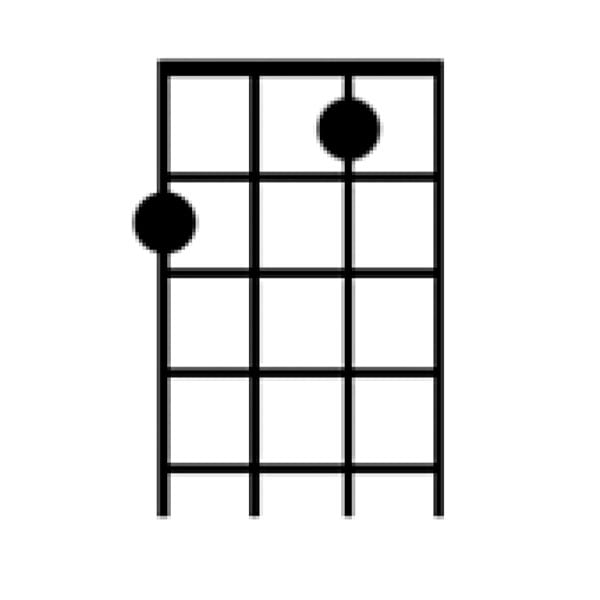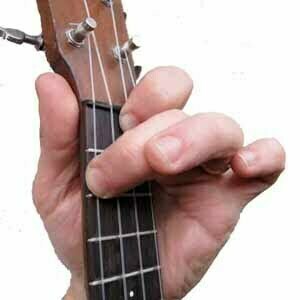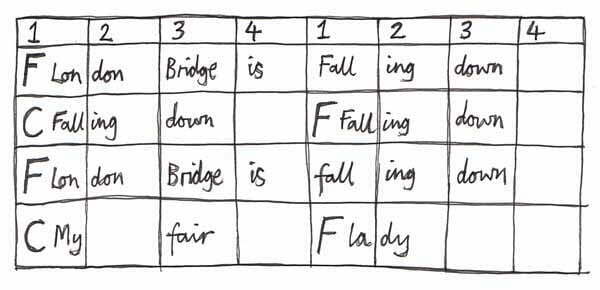This is my absolute beginner’s guide to playing the ukulele and assumes no prior musical knowledge. The idea is that it’ll get you singing and playing lots of tunes, and it won’t have been a struggle. The ukulele is an easy instrument to learn and quickly rewarding. The most important thing to remember is to have fun with it and not get bogged down. If you’re finding anything tricky, have a cup of tea.
For those of you who want to learn another chord, here goes. The next one is F, and the chord box looks like this:


The easiest way to play this is to use your forefinger on the E string and your middle finger on the G string, as shown in the image.
And it should sound like this
It may seem as if your fingers will never learn how to get into this position, but they will – it just takes a little practice. You’re aiming to put the C and the F chords together so you can learn a song. A good way to get your fingers used to it is to practice playing 4 strums on C and then 4 strums on F, trying to keep the rhythm steady as you change between the chords.
It doesn’t matter how slowly you go, to begin with, but getting used to changing chords is the KEY to playing the ukulele. Keep practising, and take breaks in between. You’ll find that every time you come back to practice again, you’ll be able to change the chord a little quicker until you can do it without your tongue sticking out of the side of your mouth like an idiot.
Now, you can put the C and the F chords together and play a song. This time, it’s another kid’s tune: London Bridge is Falling Down.

This is how the tune should sound:
A bit of a groovier tune to try is Down in the Valley, an old folk tune, but better know sung by Solomon Burke or Otis Redding. Here’s a little clip of me singing it. Just use the C and F chord as you strum along. It starts on an F chord, and I’ll call out the chord changes when they come:
Nearly all of rock, blues, reggae and pop music is based around three chords. In the key of C, these chords are C, F and G. Now that you’ve learnt C and F, you’re two-thirds of the way towards knowing about a million songs, so don’t give up now. The third chord to try is a G7 and here’s what the chord box looks like:


The easiest way to play this is to use your forefinger on the E string, your middle finger on the C string and your third finger on the A string, as shown in the image.
This is how it should sound:
Again, practice changing chords. In the next song you’ll use C and G7, so have a go at changing between these two chords – again, do 4 strums on each and then change position.
Once you feel ready, have a go at the next tune, which is Singing in the Rain, and very simple to play.
The best way to play this is to try it with me singing along (click the audio button below). Make sure you ukulele is in tune! – Start on the C chord and just keep on playing it until I get to the words‘Happy again’ when you change to the G7. – At the words, ‘Ready for love’, change back to the C chord – Go back to G7 on the words, ‘Smile on my face’ – Play a a final C chord on the last word, ‘Rain’. It may sound complicated, but it’s very straightforward if you listen to the tune:
A favourite of mine with only C and G7 is Hank Williams’ Jambalaya. You could try playing along with THIS little clip. Here’s a clip of me doing it with just the ukulele and I call out when the chords change (the first chord is G7):
So now you can put the C, F and G7 together in a song. When the Saints Go Marching In is a good one to start with. The first note to sing (for Oh) is a G (the string nearest your nose).
Here’s the chord boxes.

This is how the tune should sound:
This is something of a classic chord progression, which loads of different songs employ. Try singing Sloop John B, or She’ll Be Coming Round the Mountain over exactly this chord pattern; you’ll find they sound pretty good, too.
Another classic chord progression, which repeats repeatedly, is used in (among others) Twist and Shout. These are the chords:

So it sounds like this:
Now try singing Wild Thing over the same chord pattern. This rock and roll lark turns out to be easy eh?
Now you have a few chords, you should try experimenting with some different ways of strumming the strings, so you can bring more texture and rhythm into your playing – that’s part of what you’ll look at in Lesson 3.
